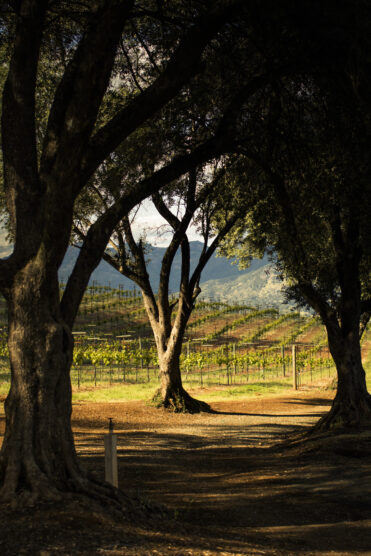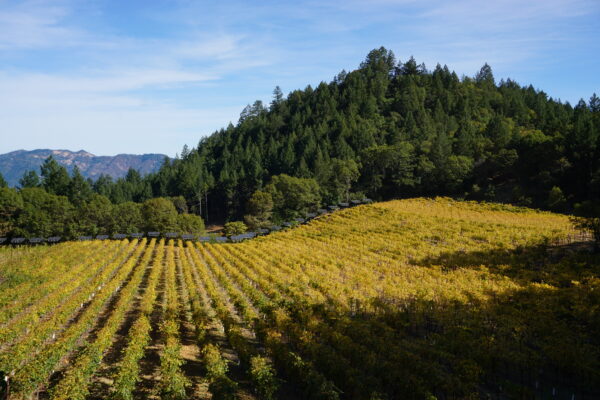In Napa Valley’s Spring Mountain District, What’s Old Is New Again
The mountains are calling.
At the top of the Spring Mountain District AVA, Smith-Madrone occupies a rollicking patchwork property.
The drive up Spring Mountain Road is not for the faint of heart at the best of times, but driving up it in the behemoth that is a modern-day Dodge Challenger, as I did during my recent visit, can be downright bloodcurdling. The two-lane highway departing from the western reaches of posh St. Helena is a remnant of Napa Valley’s more spartan past. The road’s cracked and crumbling asphalt ascends rapidly as it winds around protruding rock formations, narrows to one lane between two hulking redwood trees, and is covered in debris from windstorms that have been blowing through the valley.
Dotting the otherwise rugged landscape, however, are parcels of well-kempt vines—the vineyards that make up Spring Mountain District AVA (American Viticultural Area). On the eastern slopes of the Mayacamas Mountains, about 50 kilometres from the Pacific Ocean and up to 800 metres above sea level, Spring Mountain is the coolest and wettest of all Napa Valley AVAs. With just over 30 wineries and winegrowers and 1,000 acres of vines, this 8,600-acre subappellation accounts for only a small percentage of Napa Valley’s total wine production. Perhaps unsurprisingly, it is home to some of the most idiosyncratic wineries and winemakers in Napa Valley, many of whom who have been operating for upwards of 50 years, making wines that receive little fanfare from the general public but great acclaim in wine circles.
These wines are what some refer to as “old Napa,” anachronisms from the world before Mega Purple and oak chips—maladies for which the region has (in some ways unfairly) become the poster child. Perhaps no wine region has been more injured by “Parkerization” (the term coined to refer to the industry shift that followed the outsized scores wine critic Robert Parker gave to big, bold, highly alcoholic wines) as Napa Valley, where the heat, and perhaps a bit of American brashness, allowed these wines to be produced en masse. But current consumer trends, buoyed by the natural wine movement, among others, favour wines that are lean, are lower in alcohol, and show terroir rather than winemaker input. Because of Spring Mountain’s medium-high elevation and relatively temperate climate, the best of its wines fall in that category.

Smith-Madrone Vineyards & Winery
At the top of the mountain both figuratively and literally is Smith-Madrone, the quinquagenarian winery owned and operated by the enigmatic Smith brothers, Stuart and Charles. Charles—the older brother, who was described by the novelist and sometimes wine writer Jay McInerney as a “bearded mountain man”—is the winemaker, and Stuart (“another Grizzly Adams look-alike”) is the vineyard manager, general partner, and friendly face of the winery. Smith-Madrone occupies a rollicking, patchwork property on which 34 acres of grapes are planted on slopes ranging from pastoral to nearly vertical. Among the plantings are Napa Valley stalwarts (cabernet sauvignon, chardonnay), upstarts (cabernet franc), and restarts (merlot). But the most intriguing grape grown there is riesling, a regional outlier on which Smith-Madrone has made its name.
Because of the dry Mediterranean climate in most of the valley, when grown there, the aromatic German grape often lacks its characteristic acidity, and its bright fruit flavours fall flat. But thanks to Spring Mountain’s temperateness, pioneering wineries like Smith-Madrone are able to make top-tier examples of cool-climate grapes like riesling. The 2019 that I tasted in Smith-Madrone’s winery—a nearly windowless structure that looks more like a tool shed than a production facility for fine wine—encapsulates the potential of Spring Mountain with its taut acidity and multilayered orchard fruit.
While Spring Mountain’s altitude allows grapes like riesling to flourish, the weather event that most markedly affects the relative quality of its wines is undoubtedly fog. Because of the Napa’s proximity to the Pacific Ocean, fog regularly blankets the valley floor, keeping the morning temperatures cool before it burns off and lets the full force of the sun through. However, the fog rarely reaches 450 metres above sea level, so most Spring Mountain vineyards experience full days of sunshine—warmer mornings and cooler daytime highs. The additional sunshine these vineyards receive means reds can develop powerful tannic backbones and concentrated red-fruit flavours alongside the acid and concentration typical of cooler, high-altitude regions.

Keenan Winery
A couple of perilous turns downhill from Smith-Madrone, Keenan Winery is producing some of the most elegant reds in Napa Valley. Founded in 1974 by Robert Keenan, and now operated by his son, Michael, Keenan Winery’s vineyards receive ample sunlight throughout the growing season because of their altitude, resulting in deeply concentrated wines that are worlds away from Parkerized Napa. Of particular interest is its zinfandel. Once thought to be the only Vitis vinifera grape indigenous to North America (later DNA analysis found it to be genetically identical to the indigenous Croatian variety crljenak kaštelanski), zinfandel is in many ways representative of overwrought American wine: inky, oaky, and, honestly, a little boring. Keenan’s zinfandel, however, is nothing like those wines. Stony, herbal, and full of tart red fruit, it’s the type of zinfandel that can only be made at high elevations under plentiful sun—one as equally well suited for pairing with riblji paprikaš as with steak.
Whether with an elegant example of a cool-climate grape or a tamed version of a regional stalwart, Napa Valley’s Spring Mountain District AVA is proof that the estimable wine region has the potential to adapt to the wine world’s rapidly shifting consumer trends. In other words: the drive up Spring Mountain may be hard, but the wine goes down easy.




